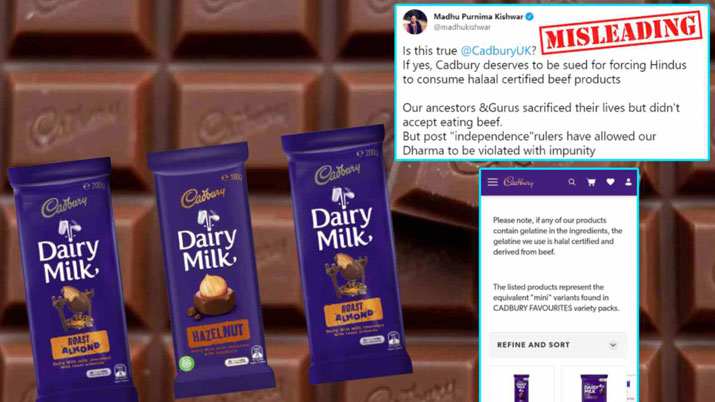Recently, a message went viral on social media which claims that Cadbury chocolates contain beef. A screenshot from a website was circulated on several social media platforms according to which, if a product contains gelatine as an ingredient that means it was derived from beef. Several people shared this screenshot to claim that Cadbury products sold in India contain beef. And several people asked to boycott the products.
A Twitter user tweeted, “Only #boycottcadbury won’t do. Must be penalize for playing with religious beliefs and law of the country (displaying green dot on wrapers) inspite of animal source is added.”
Meanwhile, another tweeted, “@DairyMilkIn can you clarify the emulsifiers used in the products are plant based or animal based with proof. Because @fssaiindia clarified in RTI that they don’t have any methods to check whether emulsifiers are vegetarian or not.”
“Is this true @CadburyUK? If yes, Cadbury deserves to be sued for forcing Hindus to consume halaal certified beef products. Our ancestors & Gurus sacrificed their lives but didn’t accept eating beef. But post “independence” rulers have allowed our Dharma to be violated with impunity,” Delhi-based academic and rights activist Madhu Purnima Kishwar also tweeted.
As more and more people shared the screenshot and commented on the issue, Cadbury Dairy Milk tweeted its clarification and responded to Twitter users. Some users even pointed out that the screenshot being shared is that of Cadbury Australia’s website.
But the company dismissed the claim saying that the message is misleading as it does not relate to India, and its products sold in India do not contain any beef or any other meat-based ingredients. Many people also tagged the official handles of the company to clarify on the issue, and the company replied to them informing that screenshot shared by them is not related to Mondelez products manufactured in India.
The company clarified the claim on Sunday and said, “The screenshot shared in the Tweet is not related to Mondelez/Cadbury products manufactured in India. All the products manufactured and sold in India are 100% vegetarian. The green dot on the wrapper signifies that.”
The company also mentioned that such negative posts damage consumer confidence in its well-respected and loved brands, including Cadbury.
Mondelez asked people to verify factual information before sharing such screenshots.
Some Twitter users celebrated after the clarification that Cadbury’s Indian version is “pure pure and double pure, 100 percent vegetarian.”
Others tweeted about Mondelez UK’s earlier clarification dating back to September 2020, where it said that it uses milk and eggs as the key ingredients in chocolates.
Cadbury, formerly Cadbury’s and Cadbury Schweppes, is a British multinational confectionary company fully owned by Mondelez International (originally Kraft Foods) since 2010. It is the second largest confectionery brand in the world after Mars. Cadbury is internationally headquartered in Uxbridge, west London, and operates in more than 50 countries worldwide. It is known for its Dairy Milk chocolate, the Crème Egg and Roses selection box, and many other confectionery products. One of the best-known British brands, in 2013 The Daily Telegraph named Cadbury among Britain’s most successful exports.
Cadbury was established in Birmingham, England in 1824, by John Cadbury, a Quaker who sold tea, coffee and drinking chocolate. Cadbury developed the business with his brother Benjamin, followed by his sons Richard and George. George developed the Bournville estate, a model village designed to give the company’s workers improved living conditions. Dairy Milk chocolate, introduced in 1905, used a higher proportion of milk within the recipe compared with rival products. By 1914, the chocolate was the company’s best-selling product. Cadbury, alongside Rowntree’s and Fry’s, were the big three British confectionery manufacturers throughout much of the 19th and 20th centuries.


